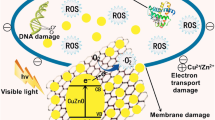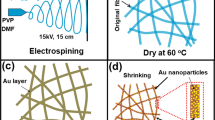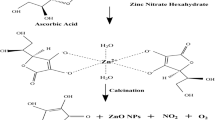Abstract
As one of extensively used photocatalysts, zinc oxide nanoparticles (ZnO NPs) can generate free radicals under proper light irradiation, thereby achieving excellent antibacterial performance. However, the requirement of using light activation has limited its application to wider fields. In addition, nano-copper (Cu NPs) have gradually attracted the attention of researchers due to their excellent antibacterial properties. However, the high surface activity of nanoparticles makes them easy to agglomerate, and Cu NPs are easily oxidized, which affect the antibacterial activity. By synthesizing Cu–ZnO composite nanoparticles and loading the particles onto low melting-point polyethylene terephthalate (LMPET) fibers, we have developed a novel catalytic fiber (Cu–ZnO@LMPET) that can generate active species without needing light. It was found that Cu–ZnO@LMPET fibers with the copper content of 5 wt% (vs. ZnO NPs) or above could achieve 99% antibacterial effects on S. aureus and E. coli under dark conditions. Moreover, the antibacterial rates against E. coli and S. aureus could still be larger than 97 and 98%, respectively, even if the fibers were washed 50 times. In-vitro biocompatibility assessment also displayed that the as-prepared fibers had superb cytocompatibility. These results indicate that our developed fibers have highly efficient antibacterial properties, good washing resistance and high stability. Thus, our work has shed new light on the use of Cu–ZnO NPs for antibacterial purposes.
Graphical Abstract












Similar content being viewed by others
References
Hendaus MA, Jomha FA (2021) J Biomol Struct Dyn 39:4185–4191
Ben YJ, Fu CX, Hu M, Liu L, Wong MH, Zheng CM (2019) Environ Res 169:483–493
Gupta A, Mumtaz S, Li CH, Hussain I, Rotello VM (2019) Chem Soc Rev 48:415–427
Wang Y, Yang YN, Shi YR, Song H, Yu CZ (2020) Adv Mater 32:1904106
Saidin S, Jumat MA, Mohd Amin NAA, Saleh Al-Hammadi AS (2021) Mater Sci Eng: C 118:111382
Qais FA, Shafiq A, Khan HM, Husain FM, Khan RA, Alenazi B, Alsalme A, Ahmad I (2019) Bioinorg Chem Appl 2019:4649506
Zhang X, Zhang G, Chai M, Yao X, Chen W, Chu PK (2021) Bioact Mater 6:12–25
Gurunathan S (2019) Arab J Chem 12:168–180
Svetlichnyi V, Shabalina A, Lapin I, Goncharova D, Nemoykina A (2016) Appl Surf Sci 372:20–29
Liu J, Wang Y, Ma J, Peng Y, Wang A (2019) J Alloy Compd 783:898–918
Jiang J, Pi J, Cai J (2018) Bioinorg Chem Appl 2018:1062562
Panchal P, Paul DR, Sharma A, Choudhary P, Meena P, Nehra SP (2020) J Colloid Interf Sci 563:370–380
Huo S, Ding S, Zhao C, Wang C, Yu F, Fang J, Yang Y (2020) Catal Lett 151:1937–1947
Van Thuan D, Khoa NT, Kim S-W, Chung JS, Hur SH, Kim EJ, Hahn SH, Wang M (2017) Catal Lett 147:2440–2447
Xi J, Wei G, An L, Xu Z, Xu Z, Fan L, Gao L (2019) Nano Lett 19:7645–7654
Jessop IA, Perez YP, Jachura A, Nunez H, Saldias C, Isaacs M, Tundidor-Camba A, Terraza CA, Araya-Duran I, Camarada MB, Carcamo-Vega JJ (2021) Polym 13:401
Phan DN, Dorjjugder N, Saito Y, Khan MQ, Ullah A, Bie X, Taguchi G, Kim I-S (2020) Mater Today Commun 25:101377
Powar NS, Patel VJ, Pagare PK, Pandav RS (2019) Chem Methodol 3:457–480
Wang L, Hu C, Shao L (2017) Int J Nanomed 12:1227–1249
Naradala J, Allam A, Tumu VR, Rajaboina RK (2022) Biointerface Res App 12:1230–1236
Zhang Y, Pan T, Yang Z (2020) Chem Eng J 389:124433
Arslan M, Günay K (2018) Int J Polym Mater Po 68:811–818
Xu S, Lu W, Chen S, Xu Z, Xu T, Sharma VK, Chen W (2019) Chem Eng J 375:121949
Arif M, Monga S, Sanger A, Vilarinho PM, Singh A (2018) Vacuum 155:662–666
He M, Lu L, Zhang J, Li D (2015) Sci Bull 60:227–234
Jiménez-Hernández L, Estévez-Hernández O, Hernández-Sánchez M, Díaz JA, Farías- Sánchez M, Reguera E (2016) Colloid Surface A 489:351–359
Norouzi A, Nezamzadeh-Ejhieh A, Fazaeli R (2021) Mat Sci Semicon Proc 122:105495
Pillai AM, Sivasankarapillai VS, Rahdar A, Joseph J, Sadeghfar F, Anuf AR, Rajesh K, Kyzas GZ (2020) J Mol Struct 1211:128107
Manjari G, Saran S, Devipriya SP, Rao AVB (2018) Catal Lett 148:2561–2571
Pimpliskar PV, Motekar SC, Umarji GG, Lee W, Arbuj SS (2019) Photoch Photobio Sci 18:1503–1511
Xiao S, Zhao L, Lian J (2013) Catal Lett 144:347–354
Kumar R, Umar A, Kumar G, Nalwa HS (2017) Ceram Int 43:3940–3961
Wang P, Yang L, Li J, Sadeh B (2020) Catal Lett 150:1985–1992
Ramesh S, Vetrivel S, Suresh P, Kaviarasan V (2020) Mater Today: Proc 33:2626–2630
Huang Z, Bi L, Zhang Z, Han Y (2012) Mol Med Rep 6:709–715
Chen CH (2010) J Appl Polym Sci 87:2004–2010
Saravanan R, Thirumal E, Gupta VK, Narayanan V, Stephen A (2013) J Mol Liq 177:394–401
Al-Gaashani R, Radiman S, Daud AR, Tabet N, Al-Douri Y (2013) Ceram Int 39:2283–2292
Wang J, Wang Z, Huang B, Ma Y, Liu Y, Qin X, Zhang X, Dai Y (2012) Acs Appl Mater Inter 4:4024–4030
Devaraj M, Saravanan R, Deivasigamani R, Gupta VK, Gracia F, Jayadevan S (2016) J Mol Liq 221:930–941
Tahir D, Tougaard S (2012) J Phys Condens Matter 24(13):135005
Lu L, Hu S, Lee H-I, Wöll C, Fischer RA (2006) J Nanopart Res 9:491–496
Lennox AJJ, Bartels P, Pohl M-M, Junge H, Beller M (2016) J Catal 340:177–183
Li X, Ji X, Chen K, Ullah MW, Yuan X, Lei Z, Cao J, Xiao J, Yang G (2020) Biomater Sci 8:2797–2813
Kunliang L, Zhicheng J, Xiaolong H, Dan Y, Yu Z, Haidong Z, Gaojun T, Fei X (2020) Int J Biol Macromol 142:866–878
Du L, Huang Y, Zhang Q, Zhou Y, Huang J, Yan L, Yu Z, Qin A, Yang H, Chen M, Liang L, Bian B, Li X, Fu J (2019) Acta Biomater 88:370–382
He M, Lu L, Zhang J, Li D (2015) J Nanosci Nanotechno 15:6435–6443
Agnihotri S, Mukherji S, Mukherji S (2013) Nanoscale 5:7328–7340
Herman A, Herman AP (2014) J Nanosci Nanotechno 14:946–957
Wang X, Lu W, Zhao Z, Zhong H, Zhu Z, Chen W (2020) Chem Eng J 400:125872
Meng S, Wu H, Cui Y, Zheng X, Wang H, Chen S, Wang Y, Fu X (2020) Appl Catal B: Environ 266:118617
Nguyen PY, Carvalho G, Reis MAM, Oehmen A (2021) Water Res 188:116446
Dong L, Xu T, Chen W, Lu W (2019) Chem Eng J 357:198–208
Acknowledgements
This work was supported by the "Pioneer" and "Leading Goose" R&D Program of Zhejiang (No. 2023C01207), National Natural Science Foundation of China (No. 12104405, No. 51703201) and Zhejiang Provincial Natural Science Foundation of China (No. LQ17E030003).
Author information
Authors and Affiliations
Corresponding author
Additional information
Publisher's Note
Springer Nature remains neutral with regard to jurisdictional claims in published maps and institutional affiliations.
Supplementary Information
Below is the link to the electronic supplementary material.
Rights and permissions
Springer Nature or its licensor (e.g. a society or other partner) holds exclusive rights to this article under a publishing agreement with the author(s) or other rightsholder(s); author self-archiving of the accepted manuscript version of this article is solely governed by the terms of such publishing agreement and applicable law.
About this article
Cite this article
Fang, Y., Chen, F., Qin, X. et al. Cu–ZnO Composite Nanoparticles Loaded Catalytic Fiber Efficiently Inactivates Bacteria by Generating Active Species Without Needing Light. Catal Lett 154, 94–106 (2024). https://doi.org/10.1007/s10562-022-04070-8
Received:
Accepted:
Published:
Issue Date:
DOI: https://doi.org/10.1007/s10562-022-04070-8




